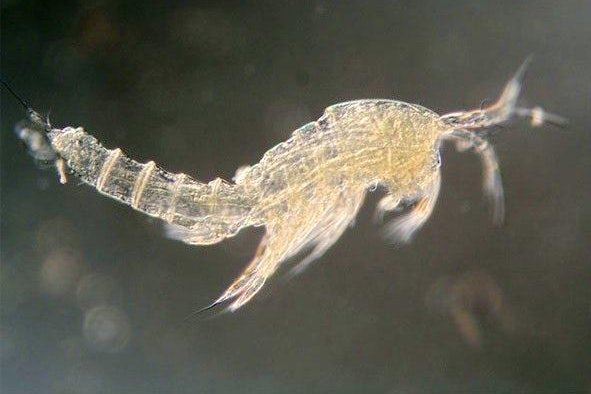A harpacticoid copepod, one of many meiofauna, was collected at a hydrothermal vent site during an expedition by the National Oceanic and Atmospheric Administration. Image courtesy of NOAA
Aug. 15 (UPI) -- Far beneath the ocean waves lies the benthic zone - the cold dark region at the bottom of the sea that is home to some of the most important marine organisms, called meiofauna. No larger than a few grains of table salt, the tiny creatures live in and around seabed sediment and play a crucial role breaking down organic matter in the deep ocean and recycling nutrients throughout the marine food chain.
Now scientists have discovered that meiofauna are also consuming microscopic pieces of plastic that have filtered down to the seafloor as plastic trash on the surface disintegrates. Scientists say this microplastic has the potential to change the way meiofauna organisms, and thus the ocean ecosystem, function.
"There is now a wide range of literature that shows microplastics can cause physical harm to organisms when ingested," said Lucy Woodall, a marine biologist at Oxford University. She recently co-authored an analysis of sediment cores that shows that the seafloor is a significant repository for microplastic. In a second study, Woodall and several other scientists from the United Kingdom found plastic fibers inside seafloor organisms when they dissected them.
Woodall's work indicates there's reason to believe that the ocean floor may be a significant repository for marine plastic. She and an international group of researchers extracted pieces of plastic from seabed sediment and deep-water coral collected from an average depth of 3,000 feet but as deep as 11,000 feet. They found that microplastic was four times more abundant in terms of units per volume in deep-sea sediments than previous studies had found in the surface waters of the Atlantic and Indian oceans and the Mediterranean Sea. The researchers discovered microplastic buried as deep as 4 inches in sediment, according to an analysis of core samples.
The scientists did not find only the rigid microplastic shards and beads typically studied on the ocean's surface, but also tiny plastic fibers shed from synthetic clothing. "The dominance of microfibers points to a previously underreported and unsampled plastic fraction," the study concluded. "Given the vastness of the deep sea and the prevalence of microplastics at all sites we investigated, the deep-sea floor appears to provide an answer to the question - where is all the plastic?"
It's known that petroleum-based microplastics tend to harbor large quantities of toxins, which they both absorb from seawater and leach through their rigid edges and more porous surfaces. That means meiofauna are consuming possibly contaminated microplastics from the seafloor.
And it's not just plastic's effects on bottom-dwelling organisms that have scientists concerned. At Roskilde University in Denmark, environmental risk masters student Monica Hamann Sandgaard is studying the impact of tiny marine worms on microplastic that ends up on the seafloor.
During an experiment in March, she filled several long glass tubes with seafloor sediment, benthic worms and tiny fluorescent pink plastic beads. The beads were the same size as the bits of detritus the worms naturally eat off the ocean floor. In a few others tubes, she added only sediment and worms. In the tubes with the plastic, Hamann Sandgaard found that the worms were capable of moving the material down as deep as 6 inches, results similar to those Woodall found.
"Worms aid in the burial of plastic into deeper sediment layers, so the plastic may be less available for other animals on the surface of sediment - they won't consume it," said Hamann Sandgaard. "But if worms are pushing plastic into sediments, it may mean less of a breakdown of plastic by anoxic organisms and photolytic degradation."
The environmental implications of plastic's movement through seafloor sediments remain unclear, however, and scientists say more research is needed. Woodall noted that the focus needs to be on preventing plastics from reaching the seafloor in the first place.
"Preventing the flow of plastics into the ocean is essential in order to minimize plastic-organism interactions and eventually minimize the increase of microplastics into the deep sea," she said.
![]() This article originally appeared on Oceans Deeply, and you can find the original here. For important news about ocean health, you can sign up to the Oceans Deeply email list.
This article originally appeared on Oceans Deeply, and you can find the original here. For important news about ocean health, you can sign up to the Oceans Deeply email list.















